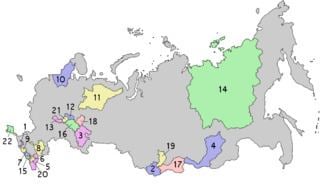Category Federated state Number 22 | Location Russian Federation Government Republic Government | |
 | ||
Populations 206,195 (Altai Republic) – 4,072,102 (Bashkortostan) Areas 3,000 km (1,200 sq mi) (Ingushetia) – 3,287,590 km (1,269,350 sq mi) (Sakha Republic) | ||
According to the Constitution, the Russian Federation is divided into 85 federal subjects (constituent units), 22 of which are republics. Most of the republics represent areas of non-Russian ethnicity, although there are several republics with Russian majority. The indigenous ethnic group of a republic that gives it its name is referred to as the "titular nationality". Due to decades (in some cases centuries) of internal migration inside Russia, each nationality is not necessarily a majority of a republic's population.
Contents
Constitutional status
Republics differ from other federal subjects of Russia in that they have the right to establish their own official language and have their own constitution. Other federal subjects, such as krais (territories) and oblasts (provinces), are not explicitly given this right. The chief executives of many republics used to have the title of president, but in 2010 an amendment to the federal law was adopted that reserves such title exclusively for the head of the Russian state.
The level of actual autonomy granted to such political units varies but is generally quite extensive. The parliamentary assemblies of such republics have often enacted laws which are at odds with the federal constitution. The republics' executives tend to be very powerful. However, this autonomy was lessened considerably under Russian President Vladimir Putin, who sought to impose the supremacy of the federal constitution.
The establishment of eight large "federal districts" above the regions and republics of Russia, with presidentially appointed governors overseeing the republics' activities, has strengthened federal control, and respect for federal supremacy in the republics. In addition, Putin strengthened the position of the republics' legislatures, while weakening their executives' power. In some republics the executive heads are elected by popular votes/for example Bashkortostan, Tatarstan etc./ while in some republics the executive heads of republics are now appointed by the President of Russia himself /for example Chechnya/. The President's nomination must be accepted by the republic's parliament. On May 30, 2014, the President of Russia, Vladimir Putin, accepted Khamitov's resignation so that he could participate in the regional elections; On 14 September 2014, most of the votes (82.17%) were given to the acting head of republic by the citizens of the Bashkortostan Republic; On 25 September 2015, the inauguration process took place in the State Council-Kurultay of the Bashkortostan Republic.
There are secessionist movements in most republics, but these are generally not very strong. However, there was considerable support for secession among Tatars, Bashkirs, Yakuts, and Chechens after the breakup of the Soviet Union, resulting in war in the case of Chechnya. The desire for secession in many republics is, however, greatly complicated by the extent to which other ethnic groups reside in their titular republics (Tatarstan, Bashkortostan, and Sakha; due to the First and Second Chechen Wars, very few non-Chechens now reside in Chechnya.) Also, the majority of Tatars, unlike other titular ethnic groups, reside outside of Tatarstan.
Status of Crimea
On March 18, 2014, the Republic of Crimea and Sevastopol were joined by treaty to the Russian Federation. Much of the international community and the Ukrainian government do not recognize Crimea's accession to Russia and consider Crimea an integral part of Ukraine.
Former Autonomous Republics and Autonomous Oblasts
The Russian SFSR of the former Soviet Union included three types of ethnic constituent units, viz., in the order of decreasing "autonomy" level: Autonomous Soviet Socialist Republics (or simply autonomous republics), autonomous oblasts, and autonomous okrugs.
After the dissolution of the USSR, each "autonomous republic" was succeeded by a republic with a similar name (or, in the case of the Chechen-Ingush ASSR, by two republics: Chechnya and Ingushetia). Several "autonomous oblasts" (Adygea, Altai, Karachay–Cherkessia, Khakassia) have become "republics" as well.
The expression "autonomous republic" is still sometimes used for the republics of Russia. Although they are autonomous and republics, the use of this term is not technically correct, since their official names, as per 1993 Russian Constitution and their own constitutions, are simply "republic", rather than "autonomous republic".
Attempted republics
There were several attempts to establish republics within Russia since 1991:
